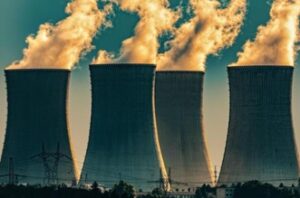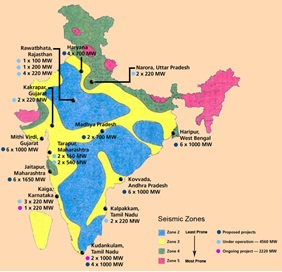Going nuclear
For a growing economy like India, leveraging nuclear energy is crucial to address climate change challenges and attain its net-zero goal
Relevance
- GS Paper 3 Conservation, environmental pollution and degradation, environmental impact assessment.
- Achievements of Indians in science & technology; indigenization of technology and developing new technology.
- Tags: #nuclear #netzero #india #cleanenergy #currentaffairs #upsc.
Why in News?
NTPC going nuclear as government’s focus shifts on small reactors in climate fight and achieve target of net zero.
India is currently experiencing rapid economic growth and is poised to climb the global economic rankings in the coming years. However, this growth is accompanied by a surge in energy demand, primarily met by fossil fuels. The heavy reliance on fossil fuels has serious implications for global warming, making climate change an urgent and existential crisis.
Net Zero
- To combat this challenge, there is a global consensus to achieve net-zero emissions between 2045 and 2070. Transitioning to net zero involves a monumental transformation of energy systems, technology adoption, and substantial costs.
- In the case of India, a large and developing nation, meeting this challenge is particularly complex. Balancing development aspirations with the net-zero target is a delicate task, as achieving both is crucial.
The Energy Dilemma
- To reach a Human Development Index (HDI) comparable to advanced nations, India needs a minimum energy consumption of 2,400 kilogram oil equivalent (kgoe) per capita per year, which could improve with greater energy efficiency.
- This translates to a clean energy requirement of approximately 25,000-30,000 TWhr/year, more than four times the current energy consumption.
- Although India is making strides in renewable energy, including solar and wind, these sources alone won’t suffice to achieve the nation’s development goals.
Embracing Nuclear Energy: A Sustainable Solution
- Considering that utilizing all uncultivable land in India for solar power generation is not feasible, the nation must turn to nuclear energy as a significant component of its energy mix.
- Overcoming the unwarranted fears associated with nuclear power is imperative. Today, nuclear energy stands out as one of the cleanest and safest energy sources for combating climate change, especially when a closed nuclear fuel cycle is adopted, minimizing waste generation.
- According to a study by the Vivekananda International Foundation, with support from IIT-Bombay, India should aim to scale up nuclear energy to a couple of thousand GWe to effectively reach net-zero emissions.
A Six-Pronged Strategy for Nuclear Energy Advancement
In India’s journey towards a rapid expansion of nuclear energy, several key strategies should be implemented:
- Indigenous 700 MWe PHWR: The Indigenous 700 MWe Pressurized Heavy Water Reactor (PHWR), already in commercial operation, should be the primary source for base load electrical capacity addition. Expanding this fleet with fifteen additional units currently under construction is vital.
- Indigenous Small Modular Reactors (SMRs): Develop indigenous Small Modular Reactors (SMRs) at sites that will become available as coal plants retire. Importing such units could render electricity production unaffordable, so partnerships with organizations like NTPC, which owns a significant number of coal plants, should be explored.
- 220 MWe PHWR Units for Energy-Intensive Industries: Offer proven 220 MWe PHWR units for partially owned captive use by energy-intensive industries such as metals, chemicals, and fertilizers. The AHWR300-LEU developed by BARC can also play a role after demonstrating its prototype.
- High-Temperature Reactors for Hydrogen Production: Develop high-temperature reactors for direct hydrogen production, enabling cost-effective green hydrogen production and reducing the pressure on excessive electrification.
- Thorium-Powered Nuclear Energy: Accelerate the development of the second and third stages of the nuclear power program to unlock the potential of thorium energy for long-term sustainable energy supply.
- Global Cooperation for Climate Change Mitigation: Encourage international cooperation to address the climate change challenge by deploying nuclear energy in emerging economies, taking advantage of India’s globally competitive PHWRs and the benefits of Thorium-HALEU fuel.
As India endeavors to achieve an annual energy production of 25,000-30,000 TWh by 2070, it’s clear that a Compound Annual Growth Rate (CAGR) of around 4.8% is feasible. For a large and rapidly growing economy like India, implementing this vision is possible, provided it’s treated as a national program and supported by a forward-thinking policy framework that places nuclear energy on par with renewables. By embracing nuclear energy and adopting a multi-faceted approach, India can address its energy needs while simultaneously contributing to global efforts to combat climate change.
| Status of Nuclear Energy in India: Key Points
· Nuclear energy is a significant contributor to India’s electricity supply, accounting for approximately 2% of the country’s total electricity generation. · India boasts a substantial nuclear infrastructure, with over 22 nuclear reactors distributed across 7 power plants nationwide. These reactors collectively generate 6,780 MW of nuclear power. · Among the nuclear reactors in operation, 18 are Pressurised Heavy Water Reactors (PHWRs), while the remaining 4 are Light Water Reactors (LWRs). · In January 2021, India achieved a milestone with the connection of the Kakrapar Atomic Power Project (KAPP-3), the country’s first 700 MWe unit. This reactor represents the largest domestically developed variant of the PHWR. · The Indian government has fostered collaboration between the Nuclear Power Corporation of India Limited (NPCIL) and public sector undertakings (PSUs) to bolster the nation’s nuclear program. NPCIL has entered into joint ventures with entities such as the National Thermal Power Corporation Limited (NTPC) and the Indian Oil Corporation Limited (IOCL). · India is actively promoting the expansion of nuclear facilities to different regions of the country. An upcoming nuclear power plant in Gorakhpur, Haryana, is set to become operational in the near future, further diversifying the nation’s nuclear energy landscape. · India is also advancing in thorium-based nuclear technology, with plans for the “Bhavni” plant, which will be the country’s first to utilize Uranium-233. Additionally, an experimental thorium plant named “Kamini” is already in operation in Kalpakkam, showcasing India’s commitment to exploring alternative nuclear energy sources. India’s three-stage nuclear program: · PHWRs: Use natural uranium, produce electricity, and yield plutonium-239 (Pu-239). · FBRs: Utilize Pu-239 for increased energy output and fissile material production. · Thorium-Based Reactors: Focus on thorium as fuel for sustainable energy production. |
Sources: Indian Express
Mains Question
“Discuss the challenges and opportunities of integrating nuclear energy into India’s energy mix to achieve net-zero emissions and sustainable development. Highlight the key strategies and policy considerations required for successful implementation. (Word Limit: 2500 words)”





